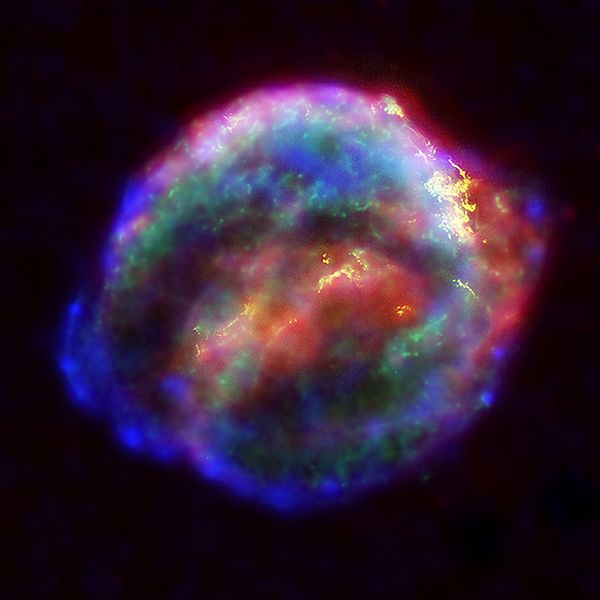Image: Keplers supernova

Description: X-ray, Optical & Infrared Composite of Kepler's Supernova Remnant "On October 9, 1604, sky watchers -- including astronomer Johannes Kepler, spotted a "new star" in the western sky, rivaling the brilliance of nearby planets. "Kepler's supernova" was the last exploding supernova seen in our Milky Way galaxy. Observers used only their eyes to study it, because the telescope had not yet been invented. Now, astronomers have utilized NASA's three Great Observatories to analyze the supernova remnant in infrared, optical and X-ray light." [1] Color Code (Energy): Blue: X-ray (4-6 keV), en:Chandra X-ray Observatory, The higher-energy X-rays come primarily from the regions directly behind the shock front. Green: X-ray (0.3-1.4 keV), en:Chandra X-ray Observatory; Lower-energy X-rays mark the location of the hot remains of the exploded star. Yellow: Optical, en:Hubble Space Telescope; The optical image reveals 10,000 degrees Celsius gas where the supernova shock wave is slamming into the densest regions of surrounding gas. Red: Infrared, en:Spitzer space telescope; The infrared image highlights microscopic dust particles swept up and heated by the supernova shock wave.
Title: Keplers supernova
Credit: http://www.nasa.gov/multimedia/imagegallery/image_feature_219.html Larger version uploaded from http://chandra.harvard.edu/photo/printgallery/2004/ a NASA-sponsored site. Per Bridgeman Art Library v. Corel Corp., no new copyright should apply anyway.
Author: NASA/ESA/JHU/R.Sankrit & W.Blair
Usage Terms: Public domain
License: Public domain
Attribution Required?: No
Image usage
The following 2 pages link to this image:

